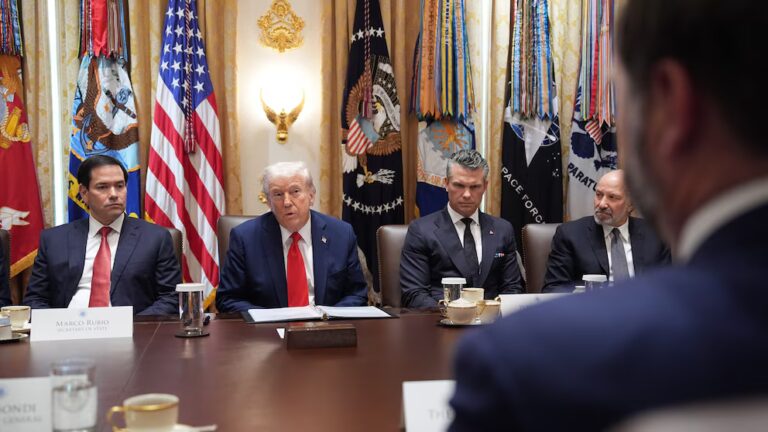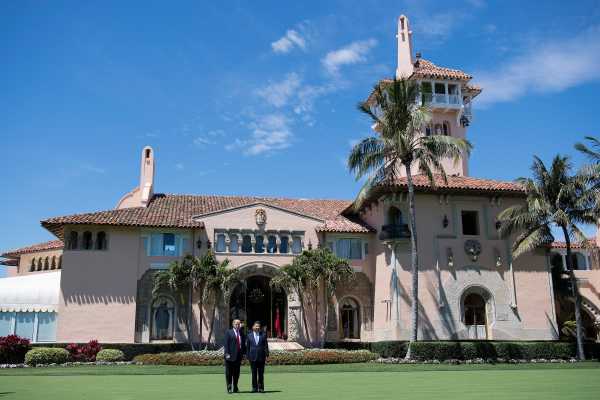
The omnibus spending bill that Congress just passed included good news for businesses that hire foreign guest workers, like the Trump Organization. The bill allows the administration to nearly double the number of H-2B visas available for companies to hire temporary foreign workers this year to 129,547.
The H-2B program is supposed to help US businesses that can’t find American workers to fill temporary jobs at hotels, ski resorts, and landscaping companies. But the law caps the number of work visas at 33,000 for the summer months and 33,000 for the winter months.
Last year, Congress allowed the Department of Homeland Security to issue more H-2B visas in 2017, as long as it didn’t surpass the highest number of H-2B visas ever issued in a year, which was 129,547 in 2007 (back then, returning H-2B workers weren’t counted in the visa cap). The agency ended up issuing an extra 15,000 in July last year, which was a low figure because the summer season was already halfway done. Congress made the same exception for the department this year.
This is great news for many seasonal businesses — including several Trump properties, such as Mar-a-Lago, which regularly hire H-2B workers to clean and cook, and serve their patrons. (In fact, on Wednesday, the day Congress revealed the spending bill, Trump National Golf Club in Westchester, New York, applied for permission to hire 14 guest workers — 10 servers and four cooks — for the summer.)
Competition for the visas has been fierce this year. The Department of Labor says it is swamped with applications from businesses that want to hire guest workers for the summer. By January 1, the department had received requests to hire 81,008 H-2B workers for the summer season — far beyond the 33,000 originally allowed.
In February, a coalition of businesses that hire H-2B workers lobbied Congress to lift the cap again. It appears Congress heard them.
Several Trump properties rarely hire US workers for seasonal jobs
The H-2B increase is good news for the president’s businesses.
For years, Trump’s golf clubs and resorts on the East Coast have relied on hiring foreign workers to serve patrons during the summer months (in New York) and the winter months (in Florida). As part of the program, employers must show that they were unable to find US workers to take the jobs. The Trump properties that use the H-2B program rarely hire US workers for these temporary positions.
A Vox analysis of hiring records for seasonal workers at three Trump properties in New York and Florida revealed that only one out of 144 jobs went to a US worker from 2016 to the end of 2017. Foreign guest workers with H-2B visas got the rest.
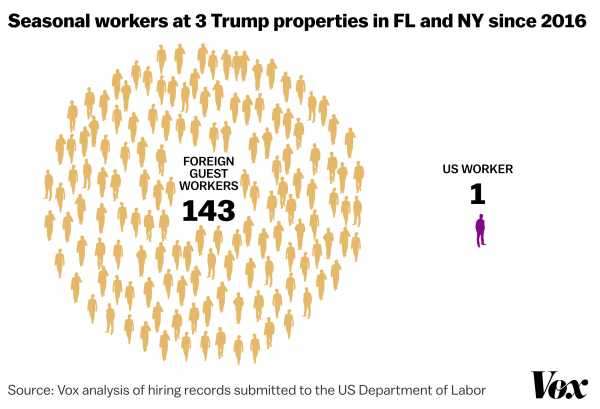

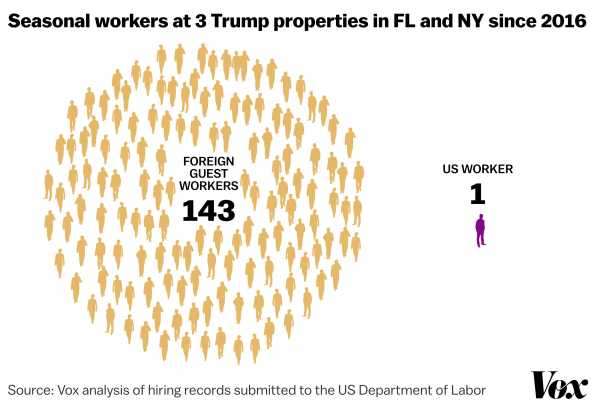
Vox reviewed recruiting files submitted to the US Department of Labor for two Trump properties in Florida (including Mar-a-Lago) and one in New York from the start of 2016 through the end of 2017. In that period, hiring managers said they were able to find and hire only one qualified American worker — a cook — for 144 open positions for servers, cooks, housekeepers, and bartenders.
A review of properties listed in a 2016 Business Insider report indicates Trump owns 17 major hotels and clubs in the US. A search of the Department of Labor database revealed three that applied for H-2B visas in 2016 and 2017.
Under the H-2B program, employers must first try to hire American workers, or legal immigrants already in the United States, at reasonable wages for their openings. If they can’t find qualified US workers, then employers can ask the Department of Labor for permission to hire foreign guest workers on H-2B visas. Documents show that hiring managers at the Trump establishments made the minimum efforts required by law to recruit US workers.
While many businesses may truly struggle to find local workers and rely on foreign workers to fill slots, the hiring practices at Trump’s properties certainly are out of step with his “America First” rhetoric and policies.
Mar-a-Lago hired dozens of foreign workers in 2017
Unemployment in the Miami area has been low in 2016 and 2017 (4.5 percent as of December 2017), and it’s harder for employers in South Florida to find workers now than a few years ago. But Vox spoke to several labor economists in the state who were nonetheless puzzled that hotels or clubs would have such a hard time finding any service workers to hire.
“It doesn’t make sense,” said Tobias Pfutze, an economics professor at Florida International University in Miami. “I haven’t heard anything about there being a labor shortage. The service labor market here is very flexible.”
In August 2017 alone, Mar-a-Lago in Palm Beach (Trump’s “winter White House”) sought permission to hire 70 servers, housekeepers, and cooks for eight months starting in October, according to recruitment reports submitted to the Department of Labor. In the paperwork, the club’s hiring manager explained the reason the club needed to hire temporary workers:
Based on the paperwork submitted, the hiring manager fulfilled the minimum effort required by law to try to find American workers first: place an ad in the local newspaper for two days, notify past employees of the openings via US mail, and post the job notice in a visible place at the club for current employees to see. Employers are required to pay the average local wage for the advertised position. Mar-a-Lago offered $10.33 per hour for housekeepers, $13.43 for cooks, and $11.88 for servers (no tips).
After waiting the required month, the hiring manager at Mar-a-Lago reported that only seven US workers responded to the newspaper job ads, and that they were either unqualified, uninterested, or did not return calls.
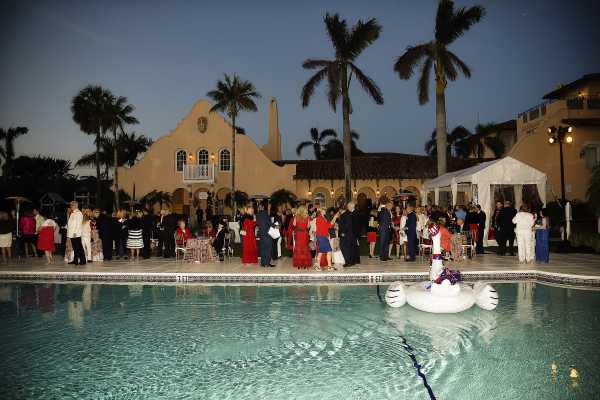

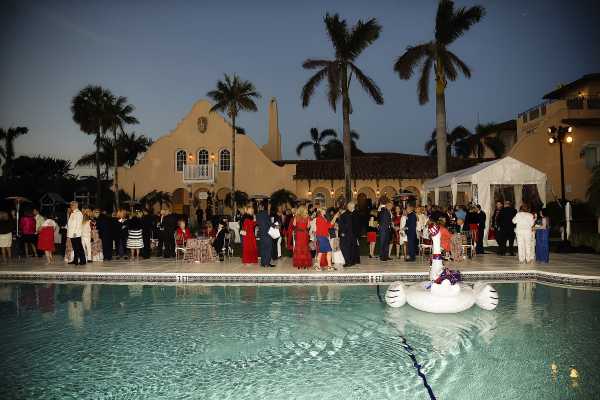
That was also the case with other Trump properties. In April 2017, the DOL allowed Trump National Golf Club in Briarcliff Manor, New York, to hire all eight of the H-2B servers the club requested. The hiring manager said no US workers applied for the jobs.
In August that year, the DOL allowed Trump National Golf Club in Jupiter, Florida, to hire all 16 of the requested H-2B servers and cooks. Again, the hiring manager reported that no US workers applied for the jobs. In all, of the 12 US workers who did apply for some of the 144 positions advertised across the three properties from 2016 to mid-2017, only one was hired.
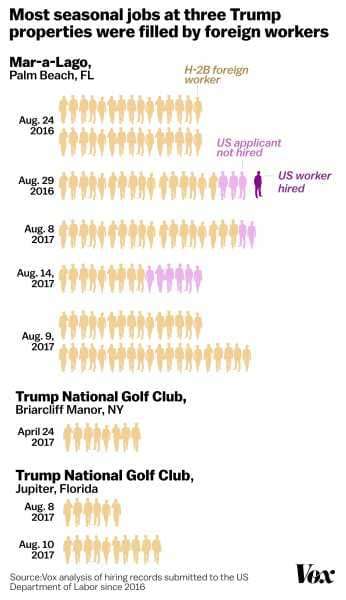

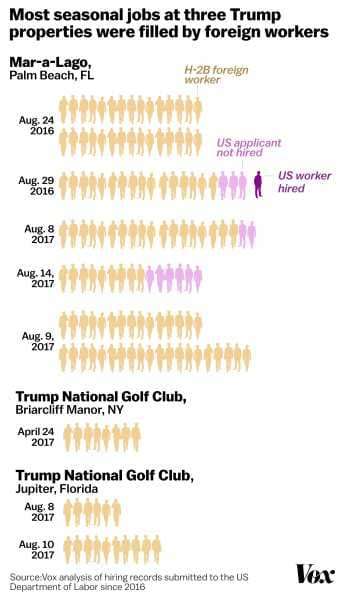
It’s unclear if the Department of Labor verifies such claims. A spokesperson for the agency told Vox he would inquire about the details of the process but did not follow up. He did not respond to another request for information.
Controversy over the H-2B program
Congress created the H-2 guest worker program in 1952 and then split it up into two separate programs in 1986: the H-2A visa for temporary farmworkers, and the H-2B visa for low-skilled workers in seasonal industries.
For years, few employers used the H-2B program, and applications rarely exceeded the 66,000 annual visa limit. By 2000, businesses had grown more comfortable with the process and competition for the visas grew more intense. Most of the workers brought to the United States on these temporary visas have few skills and come from poor countries. In 2014, most H-2B workers came from Mexico, with Jamaica and Guatemala sending many as well. Employers in Texas hired the most.
The H-2B program — like other guest worker programs — has long drawn the ire of organized labor. Business groups like the US Chamber of Commerce have repeatedly told Congress that there aren’t enough Americans willing to take temporary jobs at amusement parks, ski resorts, and hotels.
But union leaders say that’s just not true, and they accuse companies of trying to save money on labor costs by exploiting cheap foreign workers at the expense of Americans.
The process of hiring an H-2B worker isn’t easy. First, an employer has to ask the Department of Labor to calculate the most common wage for that particular job in a particular location. After getting a response a few weeks later, employers have to send a work order to the state’s workforce agency, detailing the position the business is looking to fill, the qualifications required, and the prevailing wage.
The next required step is to advertise the job in a local newspaper and hire all qualified applicants. Once the Department of Labor gives an employer permission to bring in temporary workers, they have to apply for the workers’ H-2B visas through US Citizenship and Immigration Services. Potential workers then have to meet with staff from the US Department of State at the closest American consulate in their home countries. They must also pass a criminal background check.
The process is so cumbersome that many US businesses hire a staffing company to do the work for them. Trump properties usually hire the Petrina Group, an international staffing agency with offices in New York.
Despite the lengthy process, interest in hiring workers through this program has skyrocketed. The Department of Labor said it’s swamped with applications this year, and that the “overwhelming workload” has delayed the entire H-2B certification process.
Sourse: vox.com

